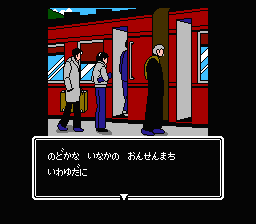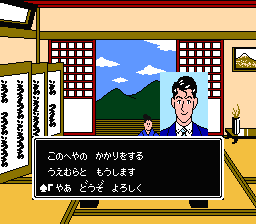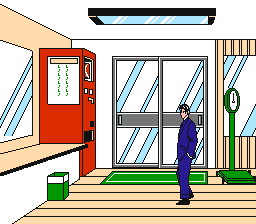Retro Replay Review
Gameplay
Akagawa Jirō no Yūrei Ressha places you in the shoes of a young detective tasked with unraveling the mystery of eight vanished villagers and the rumored Ghost Train. Movement is handled from a third-person perspective, giving you full control over your protagonist’s pacing and positioning. Rather than free-roaming, the game uses a screen-by-screen navigation system: when you reach the edge of a scene, you open a context-sensitive menu to select your next destination or action. This structure lends a methodical rhythm to exploration, encouraging players to carefully consider each available path before proceeding.
(HEY YOU!! We hope you enjoy! We try not to run ads. So basically, this is a very expensive hobby running this site. Please consider joining us for updates, forums, and more. Network w/ us to make some cash or friends while retro gaming, and you can win some free retro games for posting. Okay, carry on 👍)
Investigation segments vary by location. In some areas, a cursor lets you inspect objects, search for clues, and piece together evidence. Your detective instincts come into play as you click on suspicious footprints, loose floorboards, or weathered photographs. In other settings, conversation trees open up, allowing you to choose dialogue options when questioning villagers or fellow travelers. These interactions don’t just fill in narrative details—they may also unlock new leads or reveal hidden routes to progress your inquiry.
Puzzles strike a balance between straightforward logic challenges and more intricate riddles inspired by Jirō Akagawa’s original Ghost Train story. Certain sequences require you to combine items in your inventory or recall specific details from prior conversations. Optional side puzzles—such as decoding an old letter or unlocking a sealed chest—reward thorough investigators with extra backstory or bonus items. While not overwhelmingly difficult, these brain teasers ensure you stay engaged and invested in every step of your paranormal detective saga.
Graphics
The visual aesthetic of Akagawa Jirō no Yūrei Ressha evokes a classic early-90s adventure, blending hand-drawn backgrounds with crisp character sprites. Every rural shack, moonlit forest path, and dilapidated train carriage is rendered with atmospheric detail, capturing the eerie ambiance of a remote village haunted by rumors of the supernatural. Subtle lighting effects—like drifting lantern glow or the flicker of a distant campfire—add depth to each scene without overburdening the hardware.
Character portraits pop up during dialogue exchanges, showcasing expressive emotions that range from curiosity and fear to moments of tense confrontation. While the overall color palette leans toward subdued earth tones and shadowy blues, the occasional burst of red—bloodstained floorboards or a trailing ribbon—draws your attention and heightens the suspense. Animations remain purposeful rather than flashy; walking, examining, or conversing all feature smooth transitions that keep you immersed in the detective experience.
Occasional cutscenes and title cards interrupt the gameplay to introduce new chapters or dramatic revelations. These sequences are stylized more boldly, with sharper contrasts and stylized text overlays that underline key story beats. Though not fully animated, they employ a comic-book flair that pays homage to the mystery pulp magazines that originally popularized the Ghost Train narrative. Overall, the graphics succeed in reinforcing the game’s moody, investigative tone.
Story
Based on Jirō Akagawa’s seminal detective novel Ghost Train, the story of Yūrei Ressha retains the core allure of the original while introducing fresh twists to suit interactive play. You arrive in a secluded mountain village rife with superstition: locals whisper about an abandoned rail car that vanishes into the fog at midnight, dragging away anyone foolish enough to board. As you piece together reports of eight missing persons, the line between rational detective work and paranormal dread begins to blur.
Dialogues and journal entries deepen the world, revealing personal tragedies and long-held grudges buried beneath the village’s calm facade. Side characters—such as the eccentric stationmaster or the reclusive herbalist—each carry their own motivations and secrets. Your interrogations bring new revelations: a faded photograph that contradicts someone’s alibi, or a coded diary entry hinting at an age-old feud over the train’s construction. Such narrative branching gives you a genuine sense of agency, as each decision can influence how much truth you uncover before confronting the supernatural.
Climactic moments marry detective deduction with spine-tingling horror. As the final pieces fall into place, you’re not just matching fingerprints or unraveling clues—you’re confronting the possibility that some mysteries transcend mortal explanation. While the plot occasionally resorts to classic “locked room” tropes, it consistently subverts expectations with Akagawa’s trademark humor and human touches. The result is a story that feels faithful to its literary roots yet wholly alive in an interactive format.
Overall Experience
Akagawa Jirō no Yūrei Ressha offers a measured pace that will appeal to fans of classic point-and-click adventure games and mystery novels alike. The game’s structure—alternating between object-based investigations and dialogue exchanges—strikes a comfortable balance between exploration and storytelling. Newcomers eager for a gentle introduction to puzzle-driven adventures will find the difficulty approachable, while seasoned sleuths can hunt down every hidden collectible and side clue.
Sound design further elevates the immersion. A minimalist ambient score underscores quiet nights by the train tracks, while sudden creaks and distant whispers keep you on edge during solitary exploration. Voice snippets accentuate key moments, even if full voiceovers are limited to brief cutscenes. These audio flourishes, combined with the visual style, craft a haunting atmosphere perfectly suited to a tale of vanished villagers and phantom locomotives.
In sum, Akagawa Jirō no Yūrei Ressha is a rewarding detective adventure that brings a beloved Japanese mystery to life. Its deliberate pacing encourages thoughtful play, its graphics effectively evoke a spooky rural setting, and its narrative remains engaging throughout. Whether you’re a longtime fan of Jirō Akagawa’s works or simply seeking a polished mystery game, this title delivers a memorable ghost-train journey you won’t soon forget.
 Retro Replay Retro Replay gaming reviews, news, emulation, geek stuff and more!
Retro Replay Retro Replay gaming reviews, news, emulation, geek stuff and more!









Reviews
There are no reviews yet.